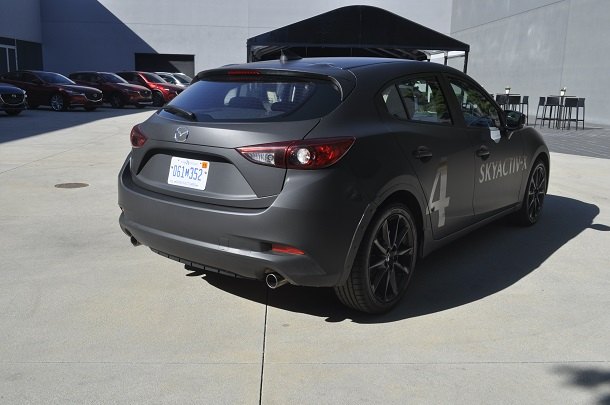Mazda Skyactiv-X Prototype First Drive - Is the Future Highly Compressed? [UPDATE]

In an era where just about every automaker is talking about electrification of its powertrains to some extent or another, Mazda is taking a different tack — remaining heavily focused on the good ol’ internal combustion engine.
This doesn’t mean electrification isn’t part of the company’s future powertrain strategy – it is – but in the nearer term, the company is working on ways to increase power while boosting fuel economy in its small gas-powered engines.
(Before we get to that, yes, the company’s long-promised diesel is still coming to America, though there’s still no official date.)
In order to show off its new tech, Mazda invited journalists to its research and development HQ in Irvine, California to drive prototypes outfitted with the Skyactiv-X engine.
Full disclosure: Mazda paid for my flight to Southern California, my hotel room, and several very nice meals. The company also gave us very nice Moleskin notebooks and pens.
The tech seminar wasn’t just about engines. Mazda is also working on improving chassis tuning in the name of comfort, as well as working on front seats designed to better fit the human body, thus reducing fatigue on long drives.
Right off the bat, I can tell you this was no normal first drive, so don’t expect a regular review. For one, the data is very much incomplete – Mazda reminded us that the engines haven’t been fine-tuned for production yet. Not to mention the cars we drove had bodies matching the current 3 – and Mazda won’t stay if this engine goes in the next 3 or something else.
That’s not surprising, but it’s a safe bet that the 2.0-liter Skyactiv-X four-cylinder I drove ends up in the next 3. Other possible applications include the CX-3, CX-5, and as a base engine in the 6. Still, given that the 3 seems due for an update and the next 6 was previewed by a concept at the Los Angeles Auto Show last fall, I’d look for this engine to show up in one of those two applications first.
I’m no engineer, but since a journalist is duty-bound to get the facts right, I am going to do my best to not screw them up. And frankly, there’s a lot to mine here.
Skyactiv-X uses what Mazda calls Spark Plug Controlled Compression Ignition (SPCCI). It has some similarities to a Homogenous Charge Compression Ignition (HCCI) engine, but Mazda claims to have conquered some challenges that have kept larger automakers from getting HCCI engines to market. The solutions Mazda came up with differentiate the Skyactiv-X enough that Mazda gave it the SPCCI name.
The simplest way to explain Skyactiv-X is that it works in some ways like a diesel. The engine uses an extremely high compression ratio (16:1) in cahoots with a very lean air-fuel mixture. That’s just the start.
Most of us know that if the air-fuel mix is compressed enough, it can detonate without a spark, but it’s also difficult to predict the point at which it will detonate. Ignition at the wrong time, of course, leads to knocking, which can damage an engine.
Mazda claims to have solved that problem by injecting a little extra fuel into the combustion chamber after the main fuel-air charge and sparking it at just the right time to keep things controlled. Essentially, instead of having all the fuel injected at one time, the injection timing is split. This keeps the air-fuel mixture too lean for auto ignition, and the fuel also has less time to heat up, again to prevent auto ignition.
A longer stroke and smaller bore also helps with this, as does a crater carved out in the piston. The engine does not have balance shafts. A longer exhaust manifold prevents exhaust pulses from one cylinder from interfering with airflow in another.
Because driving conditions change, the engine needs a lot of computer power to make everything work correctly, aided by pressure sensors that monitor conditions inside each cylinder. A clutched supercharger helps add in air when needed to get the mix correct, and valve timing adjusts/lowers the compression ratio for scenarios when the engine needs to operate more like a conventional gas engine.
Other key components include a mild hybrid setup for stop/start and aluminum construction. Mazda claims the engine will run just fine on 87 octane – no premium needed, thanks.
On the road, it’s hard to tell how different this engine really is. The only clue to its unusual operation is that occasional knock did occur during our drive – but Mazda says this will be refined out by time the engine makes production in “late” 2019.
Otherwise, it felt slightly torquier and more responsive than what’s offered in the current 3. We’d driven current-gen 3s from the hotel to the headquarters, about a 30-minute drive, and I’d snagged a manual transmission car. With both the manual and the automatic, the prototype felt peppier. However, the prototype almost certainly weighed less – there was no radio, and many under-skin production pieces likely weren’t present. I can’t say for sure, but I’d guess that most sound-deadening material, for example, and some driver aids and safety components were absent. Update: Upon publication, Mazda has reached out to clarify that the prototypes do have sound-deadening (the company says the mule is “significantly” quieter than the current car) and that they likely weigh about the same as the current model.
Mazda claims a 20 to 30 percent increase in combined fuel economy over the current 2.0-liter four-cylinder. That makes for a maximum combined fuel economy number of just over 41 mpg. A manual transmission car could see close to 50 mpg on the highway in a best-case scenario.
That’s the goal: a more fuel-efficient engine with a broader and flatter torque curve for more around-town responsiveness. If Mazda gets it right, you could have a fun-to-drive small car that also sips fuel.
Aside from the engine experience, Mazda wanted us to take note of the improvements to the chassis tuning, which aims to jostle passengers less over bumps, plus the seat comfort. I didn’t notice a huge improvement in either area. The car was maybe a tad smoother over bumps than the current 3, but I didn’t feel any less fatigued after 30 minutes of seat time than I did on the drive over. Either Mazda needs to do a little more work or my keister isn’t finely tuned enough.
I’d be remiss if I didn’t spend a section on what it’s like to drive a priceless, hand-built prototype in Orange County traffic. Maybe more-jaded journalists will scoff, but this was probably my first time behind the wheel of such a contraption. The engineer assigned to ride with us told me that if I stalled the manual, the restart procedure would be a pain, so please don’t. Which meant I slipped the clutch in ways I never do – it was like I was 17 again, learning how to drive a manual – in order to keep the car fired.
I also drove extremely conservatively to make sure I returned the vehicle without a scratch, though that doesn’t mean I was afraid to get on the gas in order to suss out the differences between the Skyactiv-X and the current engine.
One neat thing car geeks will nerd out about: an iPad attached to the dash showed which combustion mode the engine was in – SPCCI, HCCI, or conventional spark-ignition. Don’t count on this feature making production.
Mazda is geeked about the new tech, and I can understand why. Achieving more power and better fuel economy at the same time is a worthy goal, and as complex as this tech is, Skyactiv-X is based mainly in a rethinking of existing principles. It’s still an internal combustion engine, just one that’s built differently. Significantly so.
I still have questions that can’t be addressed before the engine reaches market – questions beyond whether Mazda will hit its power and fuel economy targets. For example, will Skyactiv-X engines be costlier to maintain and repair? Will this new tech run into reliability problems? Can the engine be refined in time?
Mazda told me they aren’t yet ready to discuss those issues, but they do want to provide a “positive user experience.” No matter the PR answer; the real world may have other ideas.
I’m cautiously optimistic that Mazda may be on to something here, but until the engine is officially on the market, likely under the hood of the next 3, all I can say is that the concept sounds good.
If it works, it may lead to a major change in engine design right at a time in which electrification is becoming a larger piece of the puzzle. If that happens, don’t think of it as too little, too late. Instead, think of it as one more act in the long-running series that is the ICE.
[Images © 2018 Tim Healey/TTAC]

Tim Healey grew up around the auto-parts business and has always had a love for cars — his parents joke his first word was “‘Vette”. Despite this, he wanted to pursue a career in sports writing but he ended up falling semi-accidentally into the automotive-journalism industry, first at Consumer Guide Automotive and later at Web2Carz.com. He also worked as an industry analyst at Mintel Group and freelanced for About.com, CarFax, Vehix.com, High Gear Media, Torque News, FutureCar.com, Cars.com, among others, and of course Vertical Scope sites such as AutoGuide.com, Off-Road.com, and HybridCars.com. He’s an urbanite and as such, doesn’t need a daily driver, but if he had one, it would be compact, sporty, and have a manual transmission.
More by Tim Healey
Latest Car Reviews
Read moreLatest Product Reviews
Read moreRecent Comments
- Fred This is one car I never see anymore. Where did they all go?
- Daniel Bridger The increased cost of electricity is raging faster than the government's manipulation of ICE fuel.
- Zipper69 Why the choice of a four door shell.Packing this tech into Stinger would have been awesome.
- Eric I have no desire to have an EV. Too expensive, no charging facilities within 50 miles are even planned, unproven technology, arguably even more environmentally harmful than ICE vehicles. Besides being a status symbol and to signal virtue, what's to like?
- Zipper69 Alfa Romeo Europa








































Comments
Join the conversation
Between FIAT multiair, Koningsegg camless engines, Nissans variable compression, Toyota's hybrids and Mazdas SPCCI I have a lot of hope for the future of the ICE. Now if we can just get a FIAT multiair or Koningsegg valvetrain to play nice with Mazda SPCCI pistons and injectors on a Nissan VC crank all using regular gas OY!
Quick question, the 2018 SkyactivG powered CX5 and 6 have the ability to deactivate half the cylinders: https://insidemazda.mazdausa.com/the-mazda-way/technology/mazdas-new-cylinder-deactivation/ Will the SkyactivX offer cylinder deactivation as well?